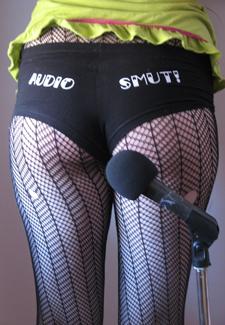The Audio Smut girls aren’t afraid to say “clitoris,” whether they’re sitting in a cafe or sitting at the mic in the CKUT studio. Put together by a feminist collective of sex-positive activists, Audio Smut is a radio show that aims to entertain, educate and arouse listeners in the Montreal area and beyond. In just three shows since October, Audio Smut has already nailed topics like lesbian kink and sexual shame, and scored interviews with Canadian artist GB Jones and writer/activist Mattilda Bernstein Sycamore. Xtra.ca spoke to Kaitlin Prest and Nora Rohman, two members of the new Audio Smut collective.
Xtra.ca: Audio Smut says it’s committed to “challenging notions of decency.” What does that mean?
Kaitlin: Audio Smut is about putting sex out there and letting it be something that we can all talk and laugh about. There’s a really common conception of sex — of open, overt sex — as being offensive. We want to transform that.
Nora: When I hear the word “decency,” it makes me think of a stuffy, English man with a monocle, like, “No no. Stop that. That’s indecent. You? That? No! Separate, an inch apart. Ruler!” That’s me being silly and facetious. But the reality is there’s a lot of that. There is a notion of what is normal sex and what is acceptable sex.
Xtra.ca: What do you think that notion is?
Nora: Obviously heterosexual, obviously over 18. We can only hear about people in their 20s having sex. We can’t hear about people who are older having sex. We can’t hear about interracial people having sex and trans people, whose bodies are different, and people with disabilities. What do you see on TV? You see sex… everybody has the sheets up here, and if there’s spanking, they totally have to die at the end of the movie. Just talking about sex is a radical act in the current cultural climate.
Xtra.ca: Can you tell me a little about the mini soap operas you do related to the theme of each show?
Kaitlin: We want to find a creative way of bringing these issues to the fore. I think that comedy and art are really good ways of changing things.
Nora: We all pack into the studio; it’s just really silly, because we’ll end up being like, “Ahh! Ahh!” [Clapping her hands to approximate spanking noises.]
Kaitlin: We’re doing it again.
[Laughter]
Nora: It’s funny when we all get together for drinks after the show… we say “clitoris” really loud in public and we’re like, “anterior wall of the vagina!” We all feed off of each other. We all have that same kind of silly, sexual…
K: Openness. I’ve always kind of gotten off on pushing people’s neuroses.
Xtra.ca: How queer is the show?
Kaitlin: Our content is really queer-positive and involves a lot of queer politics, but I feel like we’re trying to address a wider audience, to illuminate those issues to people who aren’t necessarily in queer circles and who aren’t necessarily involved in queer politics.
Nora: I’d like to learn, too, through the process. I could talk about queer and lesbian politics until I’m blue in the face. I’m excited about learning from people I interview.
Xtra.ca: What do you hope listeners take away from the show?
Nora: I hope people talk about sex more. To me, that’s where healthy sex lives start. That’s where change happens. I hope [the shows] make people feel something and have a reaction, whether it’s “That’s awesome. I never thought about that,” or “That makes me uncomfortable.” I hope that it makes them reflect in some way.
Kaitlin: If sex starts to be something that is more acceptable and normal to hear about on an everyday basis, there’s a freedom that can be gained.

 Why you can trust Xtra
Why you can trust Xtra


